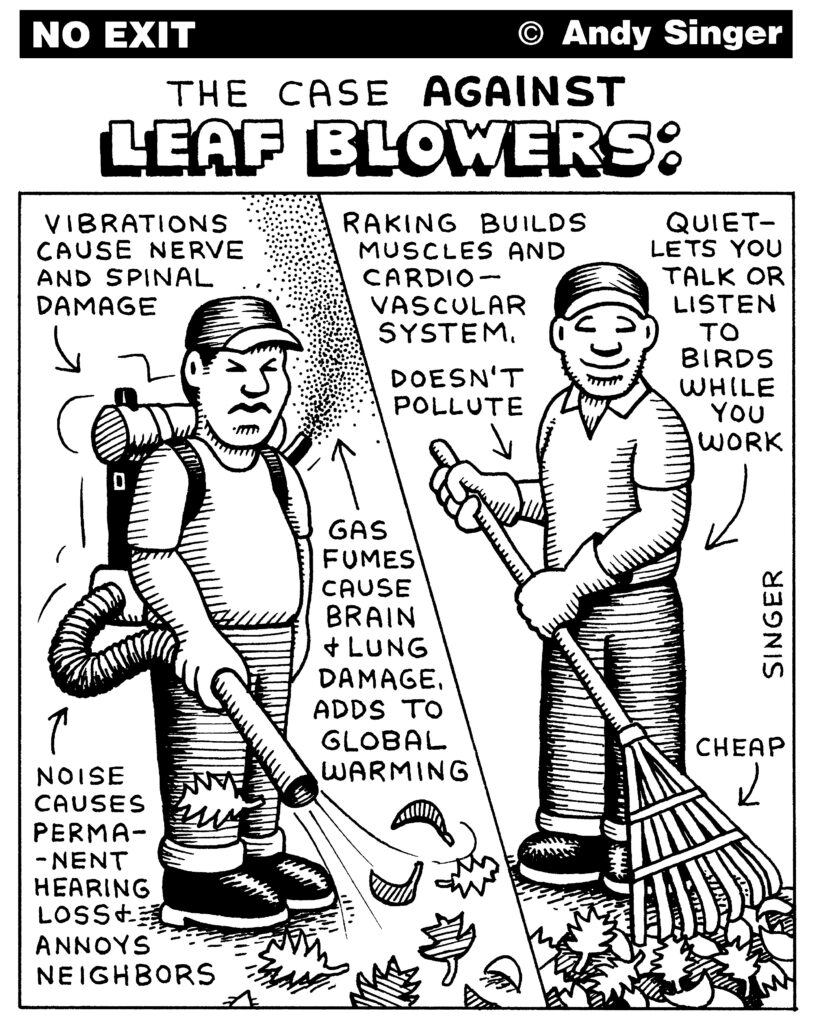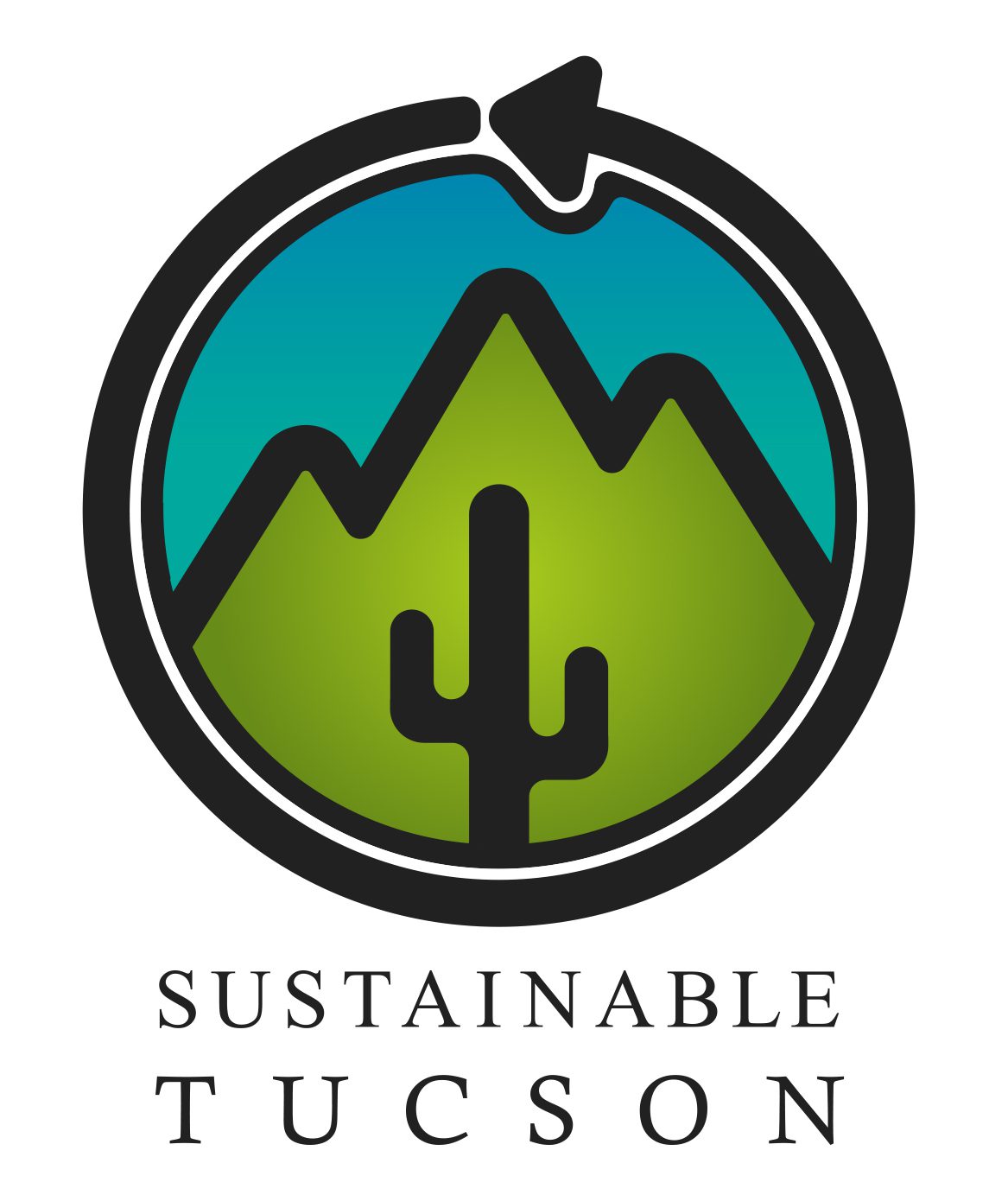For more sustainable landscaping equipment
and a healthier environment
For both environmental and health reasons, it is time to phase out the use of gas-powered leaf blowers and related yard-maintenance equipment (string trimmers, lawn mowers, etc.). Success in this endeavor will be a victory for the environment, our neighborhoods, and for landscapers, the people who are most impacted by equipment emissions, dust, and noise.
Right here in Pima County, the Department of Environmental Quality is committed to protect the air we breathe, offering residents and commercial users up to $400 in vouchers for hand-powered equipment when they turn in working gas-powered equipment. The vouchers are good for rake, broom, or electric-powered equipment.
While all gas-powered landscape equipment has similar impacts, this paper focuses on leaf blowers because of their ubiquity and often unnecessary use. Here is a brief summary of the harms created by this equipment.
Air pollution: Despite minor improvements, two-stroke engines are still inefficient, emitting out-sized portions of carbon monoxide, carbon dioxide, and fine particulates, along with hydrocarbons such as benzene, butadiene, and formaldehyde.1

Comparison of relative emissions of certain pollutants from garden equipment and automobiles.
Source: California Air Resources Board
Difficult to use properly: Manufacturers recommend safe distances of 50 feet between leaf blowers and bystanders.2 This is nearly impossible to establish in urban environments. Operators of the equipment are exposed to the bulk of emissions, even if masked.
Noise and hearing loss: Most gas-powered blowers operate between 70-100 db. Repeated exposure above 55 db can cause health problems including hypertension and cardiovascular disease. Repeated exposure to volumes above 85 db is destructive to hearing. The low frequencies of gas blower noise can travel farther and through walls, affecting up to 90 dwellings surrounding a gas blower, compared to six dwellings affected by a powerful comparable electric blower.3
Soil destruction: Gas blowers wear away topsoil and disturb ecosystems, impoverishing the soil and creating the need for external inputs such as fertilizers, adding to their climate-changing impacts.4
Alternatives exist
The future of gardening and landscape maintenance lies in quieter, cleaner, electric-powered equipment. Indeed, for many jobs, classic tools like the broom and rake do equally well, even better. Not all electric leaf blowers are as powerful as industrial-strength gas-powered ones, but they get the job done with no direct emissions and substantially less noise.

Time for action!
From DC to California, a growing number of municipalities are enacting regulations around gas powered leaf blowers and other gardening equipment.
Of particular interest is the State of California’s ban on the sale of gas-powered equipment that took effect January 1, 2024. The measure will gradually phase out the use of old technology, replacing it with greener alternatives. A study in California concluded that total emissions from gas-powered gardening equipment exceeded those from automobiles across the state, because the two-stroke engine is hundreds of times less efficient than combustion automotive engines (themselves only about 35% efficient).
What we are doing about it
We are asking the Tucson City Council to initiate a transition away from gas-powered landscaping equipment to healthier, more environmentally sound options.
Goal: A gradual phasing out of gas-powered leaf blowers and related landscaping equipment over a period of three years. Landscapers will be supported as we shift to a healthier, cleaner, and greener future in accordance with the city’s climate action plan, Tucson Resilient Together.5
Here are our recommendations to local policy makers:
- Investigate the steps taken by other municipalities which have successfully implemented such legislation in drafting a new ordinance for Tucson.
- Analyze the jurisdictional authorities of City & County regarding noise abatement. Can they restrict the operation of equipment that exceeds OSHA noise standards?
- Look at the costs and benefits of replacing all City- and County-owned gas-powered landscape equipment with manually-operated tools and/or electric power.
- Develop a collaborative learning approach with landscaping employees and managers so as to best outline the collaborative path forward.
- Bolster the County’s voucher program by highlighting information on the added benefits of using hand tools (rake & broom), which include savings in health care costs and energy. This information sharing can take place in both promotion and administration of the program.
- Consider a zero-interest loan program and/or tax credits, etc., for landscapers looking to transition to all electric.
Sustainable Tucson, a 501(c)(3) nonprofit, is collaborating with other supporting organizations, including Sierra Club Arizona, Tucson Clean & Beautiful, and Tucson Organic Gardeners, in mounting the Clean Sweep campaign to make care of our lands healthy and sustainable. We welcome your support. Please consider joining us by speaking to your neighborhood association, a City Council or Board of Supervisors meeting, or by donating at sustainabletucson.org/donate (note that it’s for Clean Sweep).
Contact us to learn more or to volunteer: Info@SustainableTucson.org
Endnotes
- Public Interest Network: Lawn Care Goes Electric ↩︎
- STIHL USA: Leaf Blowers: A Guide to Safe & Courteous Use ↩︎
- Quiet Clean PDX: GAS POWERED versus BATTERY POWERED LEAF BLOWERS ↩︎
- AP News: “There’s a movement to ‘leave the leaves’ in gardens and lawns.” Should you do it? ↩︎
- As noted in Action E-1.7 of the City’s plan: “Transition municipal landscaping equipment to cordless battery equipment and/or manual tools, and pursue AGZA Green Zone Certification” (p. 90). ↩︎
More resources
- Gas Powered Mowers are Heavy Polluters, Arizona Daily Star
- Tucson Resilient Together, City of Tucson, Action E-1.7 (p. 90): “Transition municipal landscaping equipment to cordless battery equipment and/or manual tools, and pursue AGZA Green Zone Certification”
- Why Cities are Taking Action, Audubon
- More than a hundred cities have already banned gas leaf blowers, Oregon Live
- California legislation background, CNet
California passed a law, AB 1346, banning the sale of gas-powered leaf blowers, string trimmers (weed whackers) and lawn mowers starting July 1, 2024. The law also establishes emissions reductions for existing gas-powered leaf blowers as of 7/1/22. - DC’s Leaf Blower Regulation Amendment Act of 2018, The Wash
The Act prohibits the use of gasoline-powered leaf blowers in the District of Columbia and took effect January 1, 2022. Here’s a fact sheet for the DC program. See also public health nonprofit Quiet Clean DC. - Lawn Care Goes Electric, Environment America, US PIRG, the Frontier Group (2023)
- Quiet Clean PDX: GAS POWERED versus BATTERY POWERED LEAF BLOWERS
Revised 1/23/24
